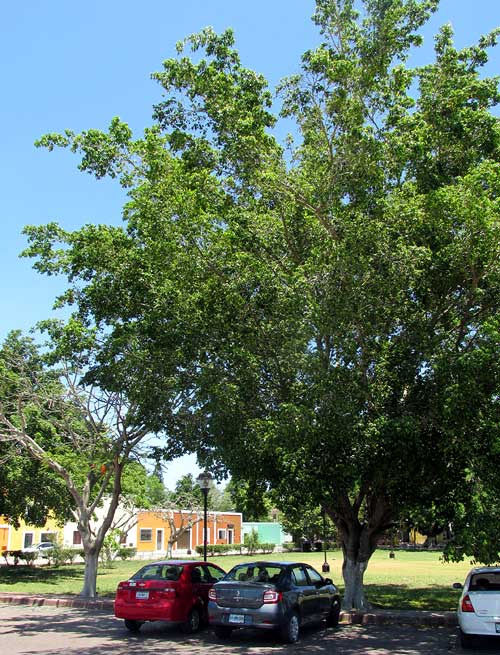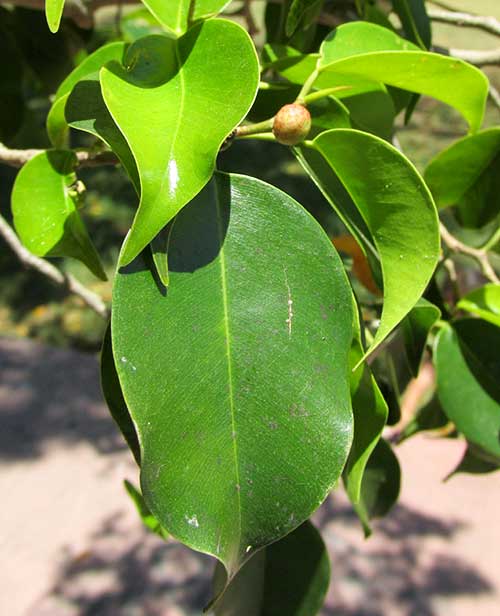Excerpts from Jim Conrad's
Naturalist Newsletter
from the May 22, 2016 Newsletter issued from Hacienda Chichen Resort beside Chichén Itzá Ruins; limestone bedrock; elevation ~39m (~128ft), N20.675°, W88.569°; central Yucatán state, MÉXICO
FIG TREE IN A PARK
A couple of weeks ago I accompanied Hacienda guests as they visited San Bernadino Convent in Valladolid about 45 minutes east of the Hacienda. With the mid-day sun bearing down very hard, our little red rental car was parked beneath a nice shade tree at the edge of the plaza in front of the convent, as shown below:

While the guests toured the convent, I wandered the area looking for interesting plants. One of them was the very tree we'd parked below. It was a fig tree, but I wasn't sure which one. Fortunately, it bore figs. Below, you can see the tree's interesting leaves, which unlike most other fig leaves gradually diminish to a point -- they're "attenuate" -- while curving under and to one side:

The figs also were a bit unusual, arising directly from the stem with no stalk, and greenish-yellow with rose-colored spots, as shown below:

Eight native fig species are listed for the Yucatan, and another eight are listed as introduced ornamental or horticultural species sometimes grown in Mexico. Since I already could identify about half of those possibilities, I figured I had a good chance of identifying our street-side fig in Valladolid. Another reason for my confidence was that recently I've downloaded from the Internet the excellent "El Género FICUS L. (Moraceae) en México," a 2012 work by Guillermo Ibarra-Manríquez and others, appearing in Botanical Sciences. That work provides excellent Spanish descriptions and technical drawings of each of Mexico's 22 or so native fig species, and can be freely downloaded from http://www.scielo.org.mx/pdf/bs/v90n4/v90n4a4.pdf
However, none of the 22 native Mexican species, and none of the eight introduced species, matched our Valladolid tree...
Still, I have a strong hunch what it is, and here I'm going to file it under that name, just to see if anyone can come up with anything better.
I think it's probably one of Mexico's 22 native species, FICUS CITRIFOLIA, a widely distributed, fairly common species occupying many habitats from upland pine forests to tropical deciduous and evergreen lowland forests, to secondary growth, from Florida in the US and most of Mexico, the Caribbean and Central America, through out most of tropical South America. It's known as an extremely variable species, and that's part of what bolsters my confidence in the name.
The main problem with the ID is that the figs of Ficus citrifolia are described as produced on little stalks, while our tree's figs very clearly arise directly from the woody branches. Also, most pictures show this species' figs as reddish with white spots, not yellow-green with red spots, as with ours.
However, not many species have leaves with such long-pointed tips that curl below and to one side. Also, the wrong colors for the figs and their lack of stalks may come about because they're immature. Besides, if our tree isn't Ficus citrifolia, there just doesn't seem to be another species coming close to it.